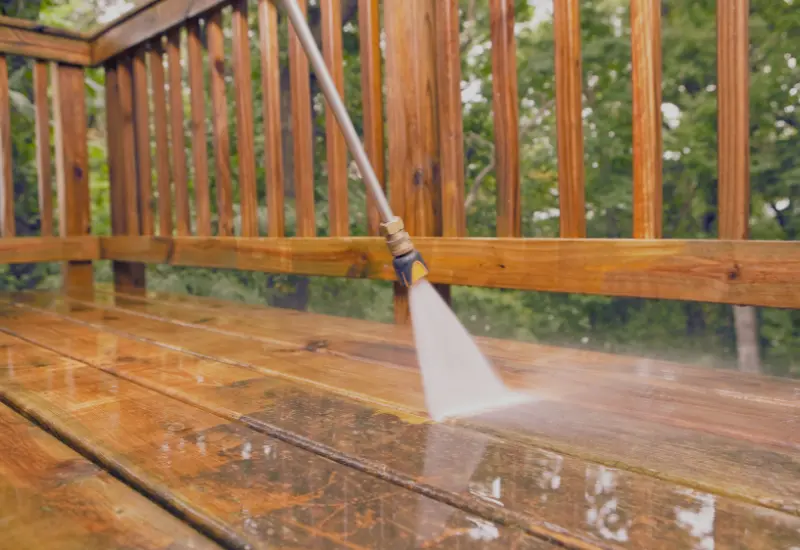
Wood surfaces, whether they’re part of your home’s interior or exterior, add a touch of warmth and elegance. Yet, maintaining their pristine condition can be quite challenging, especially when they’re exposed to the elements. Pressure washing is a popular method for tackling stubborn dirt and grime on surfaces like decks, patios, and fences. But when it comes to wood, you might wonder if this powerful cleaning technique is safe.
The truth is, pressure washing can indeed clean wood effectively, but it’s a double-edged sword. If not done carefully, it can lead to splintering or even exacerbate existing damage. The high-pressure water stream, while great for removing tough stains, can also strip away the wood’s natural fibers. So, before you unleash the power of a pressure washer on your wooden surfaces, it’s crucial to understand the potential risks and best practices.
Can You Pressure Wash Wood?
Pressure washing wood effectively cleans and removes dirt, grime, and mold. However, improper use can cause significant damage, particularly if the wood’s a softwood like pine or spruce. High pressure can splinter or gouge the surface, exposing underlying layers. Controlling the water pressure is critical. Use a pressure washer with a maximum of 150 bar to safely clean wooden surfaces.
Choose the right nozzle for optimal results. A fan-spray nozzle distributes water evenly, reducing potential harm. Keep the nozzle at a safe distance, usually 12 to 24 inches, to prevent the wood grain from lifting or splitting. Unsuitable techniques can lead to wood contracting or expanding, exacerbating damage.
Prepare your deck by removing debris first. Use a stiff broom for leaves or dirt. Test a small, inconspicuous area before washing the entire surface. Protect surrounding areas with coverings to avoid overspray damage. Wear protective gear like goggles and gloves to shield yourself from debris and water splashes.
If you notice any splintering, lightly sand the surface with medium-grit sandpaper before sealing. Applying a wood sealer enhances water resistance and prolongs the wood’s life. Keep in mind that professional pressure washing help minimizes the risk of damage, ensuring a clean, well-maintained deck.
Risks of Pressure Washing Wood
Pressure washing can effectively clean wood surfaces but carries significant risks if not done correctly.
Wood Damage and Splintering
Wood is prone to splintering, especially when high water pressure is used. If you notice split-apart sections, pressure washing might worsen the problem. Use medium-grit sandpaper to gently sand the surface and remove any raised fibers. Applying a wood sealer helps cover the damage, preventing further splintering.
Raised Wood Grain
Improper pressure washing can raise the wood grain, giving the surface a rough texture. This occurs when the water penetrates the soft fibers, causing them to swell. To avoid this, maintain a safe distance of 12 to 24 inches between the nozzle and the wood. If you encounter raised grain, lightly sand the area and apply a protective finish.
Tiger Striping
Uneven pressure results in tiger striping, where parts of the wood remain dirty or unevenly cleaned. This occurs when the nozzle isn’t held steadily, causing streaks of varying cleanliness. To prevent this, use a fan-spray nozzle and maintain consistent movement across the surface. Test a small area first to ensure even cleaning.
Best Practices for Pressure Washing Wood
Pressure washing wood surfaces requires careful technique to avoid damage while effectively cleaning. Following best practices ensures that your wood surfaces remain intact and attractive.
Selecting the Right Tip and Pressure
Choose the correct spray tip and pressure setting for your wood type. Use a fan tip with a 40 to 60-degree spread or a rotating tip, ensuring cautious use. For softwoods like cedar and pine, maintain pressure around 500 to 600 psi. Hardwoods can handle slightly higher pressure but avoid exceeding 1200 psi. Testing settings in a hidden area helps determine effectiveness without risking visible damage.
Maintaining Proper Distance
Keep the pressure washer’s nozzle at a safe distance of 12 to 24 inches from the wood surface. This strategy prevents the water’s force from lifting or splitting the wood grain. Monitor the washer’s performance on less visible wood sections like stair treads or corners to fine-tune the distance and pressure.
Ensuring Safe Application
Safety during use involves more than just technique. Wear protective gear such as goggles and gloves to shield against debris and spray. Use consistent and controlled movements to prevent uneven cleaning patterns, known as “tiger striping.” Small area testing supports even cleaning, reducing the risk of unintended surface damage.
Conclusion
Pressure washing wood surfaces can be an effective cleaning method if done with care and precision. Understanding the risks and employing best practices ensures you maintain the beauty and integrity of your wood structures. Always choose the right pressure settings and spray tips for your wood type and maintain a safe distance during cleaning. Consider testing in less visible areas and remember to follow up with proper post-wash care. If you’re unsure, seeking professional assistance can be a wise choice to avoid potential damage. By taking these steps, you can enjoy clean and well-maintained wooden surfaces for years to come.
